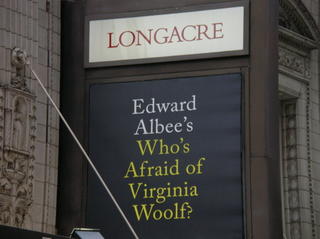
PLAY: Who’s Afraid of Virginia Woolf?
WRITTEN BY: Edward Albee
DIRECTED BY: Anthony Page
CAST: Kathleen Turner (Martha), Bill Irwin (George), David Harbour (Nick), Mireille Enos (Honey)
LOCATION: Longacre Theatre, 220 W. 48th Street, New York, NY
DATE: July 16, 2005, Matinee Performance
Anthony Page’s direction of Edward Albee’s classic piece of American drama, Who’s Afraid of Virginia Woolf?, chooses to focus on an interesting, if often underappreciated aspect of the play – its hilarity.
Sure the barbs Albee created for Martha and George to hurl at each other are humorous in their own right, but Page expands the text’s latent comedy, taking it to its logically calamitous and painful ends. But even as the audience’s laughter explodes, the uproar is painted with a touch of pathos. After all, we are laughing at the disintegration of the American ideal of marriage, the ideal so many of us build our lives around. Albee exposes the posturing and hypocrisy involved in all marriages. The humor is partially based on the familiarity of family bickering. We might not be watching our own family, but we certainly know one like it. Rancor and unhappiness possess the lead characters of Who’s Afraid of Virginia Woolf and Page deftly draws out these elements by the classic route of linking tragedy to comedy.
Martha’s frequent comments about George’s career failure and George’s constant nagging of Martha about her alcoholism are delivered with cutting wit and illuminating irony by Turner and Irwin, respectively. The two actors are masterful, the hype surrounding their performances deserved and if possible, understated. Irwin slowly brings George out of his shell until the climatic final scene when all illusions are shattered and years of pent-up frustration finally find a release. Turner is perfect for the role of Martha, her mannish features and domineering presence an appropriate fit for Martha’s haughty yet unfulfilled life. Albee’s lines take on whole new dimensions in their hands. The viewer loses track of time, the other members of the audience, even outside concerns, watching this performance. Beyond the suspension of disbelief usually required for art, the audience becomes immersed by the play, swallowed in the act like Jonah in the belly of the whale. This is Broadway at its best.
Albee’s play still has the freshness and power to provoke that it had upon first publication in 1962. Under the instruction of Page, Turner and Irwin, and to a lesser extent, Harbour and Enos, extract all the subtle and covert themes running through the play. From the way the Cold War kept the world at peace only through violence, to the misconceptions and lies at the heart of the institution of marriage, all of Albee’s intentions are on display. But even as the ending exposes in the brightest light the problems of a society structured around greed and half-truths and an aura of thorough sadness pervades the theater, we’re left with a surprising, if somewhat superficial question to ponder:
Who knew dysfunctional marriages could be so funny?
Albee of course. And maybe even Virginia way back when. And certainly this cast. That may lead us into some murky territory, the grays a red and blue America no longer has time for. How can we laugh at something so dark? But such ambiguity might be a good thing and proves, even today Albee is relevant, his black comedy bares America’s dark side whether we’re ready for it or not. You can almost here Albee’s laughter in the audience’s chorus, his voice mockingly asking:
I’m not afraid are you?
No comments:
Post a Comment